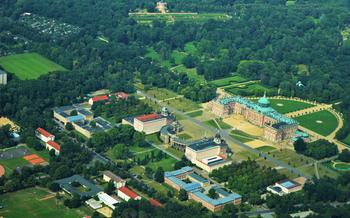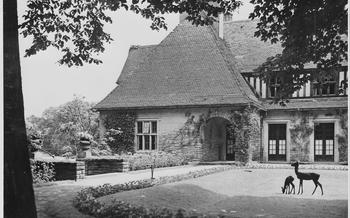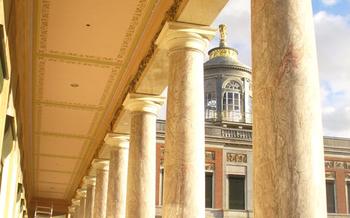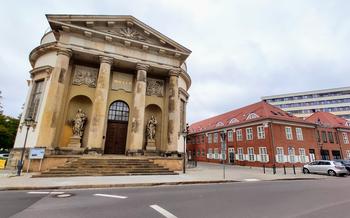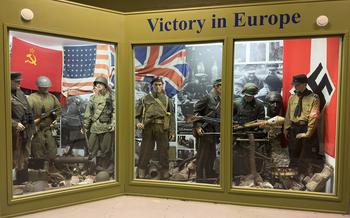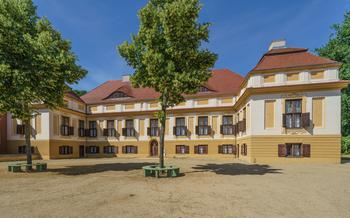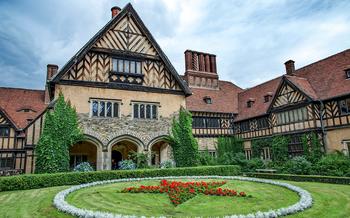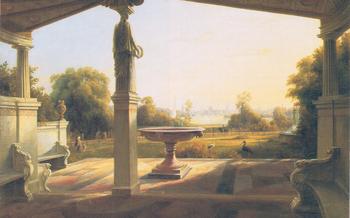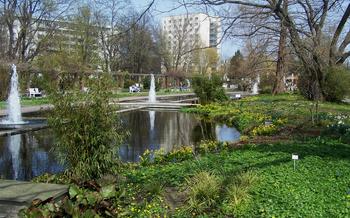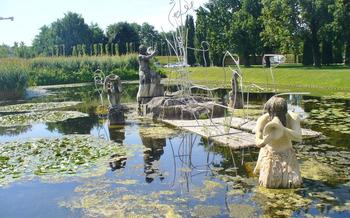
The Spy Bridge (Glienicke Bridge)
- The Glienicke Bridge: A Symbol of Cold War Espionage
- The Unique Design of the Glienicke Bridge
- The Bridge's Role in the Potsdam Conference
- The Surrounding Area: Glienicke Palace and Park
- Other Notable Spy Bridges in the World
- Visiting the Glienicke Bridge: Practical Information
- Stories and Anecdotes from the Bridge's Past
- The Bridge's Cultural Significance in Film, Literature, and Art
- The Bridge as a Symbol of Reconciliation and Unity
- The Bridge's Role in Modern-Day Diplomacy
- Conservation and Preservation Efforts
- The Bridge's Impact on Tourism in Potsdam
- The Bridge's Future Role and Significance
- Virtual Tours and Online Resources
- Insider Tip: Hidden Gems Near the Bridge
The Glienicke Bridge: A Symbol of Cold War Espionage
During the Cold War, the Glienicke Bridge served as a crucial location for spy exchanges between the United States and the Soviet Union. Situated on the border between East and West Berlin, the bridge became a symbol of the tension and intrigue that characterized the era.
The bridge's significance as a neutral territory made it an ideal location for these exchanges. Spies from both sides would be brought to the bridge and swapped, often under the watchful eyes of armed guards and intelligence officers. The bridge's role in these exchanges earned it the nickname "The Spy Bridge," and it became synonymous with the cloak-and-dagger world of espionage.
One of the most famous spy exchanges to take place on the Glienicke Bridge was the exchange of Rudolf Abel, a Soviet spy, for Francis Gary Powers, an American U-2 pilot who had been shot down over the Soviet Union. The exchange took place on February 10, 1962, and was captured in a now-iconic photograph that shows the two men walking towards each other on the bridge.
The Glienicke Bridge played a pivotal role in the Cold War, serving as a stage for some of the most dramatic and tense moments of the era. Its legacy as a symbol of espionage continues to fascinate and intrigue people to this day.
The Unique Design of the Glienicke Bridge
The Glienicke Bridge stands out not only for its historical significance but also for its unique design. Constructed in 1907, the bridge blends architectural styles, featuring elements of Romanesque Revival and Art Nouveau. Its distinctive arched form, adorned with decorative turrets and intricate carvings, adds an air of grandeur to the structure.
The bridge's design is rich in symbolism. The central arch represents the gateway between East and West Germany during the Cold War, while the two smaller arches symbolize the two nations themselves. The stone lions guarding the bridge's entrances symbolize strength and protection, emphasizing its role as a symbol of unity and reconciliation.
The bridge's construction involved a combination of materials, including granite, limestone, and sandstone. The sturdy granite piers provide a solid foundation, while the limestone and sandstone elements add a touch of elegance and detail to the bridge's overall appearance.
In recognition of its historical and architectural significance, the Glienicke Bridge has been designated as a protected historical monument. This designation ensures that the bridge's unique design and structure are preserved for future generations, allowing visitors to continue to appreciate its beauty and historical significance for years to come.
The Bridge's Role in the Potsdam Conference
The Glienicke Bridge played a pivotal role in the Potsdam Conference, a significant international gathering held in Potsdam, Germany, from July 17 to August 2, 194The conference brought together the leaders of the Allied Powers—the United States, the United Kingdom, and the Soviet Union—to discuss the postwar world order following the end of World War II.
The bridge served as a crucial link between the conference venues—the Cecilienhof Palace, where the delegations resided, and the Neues Palais, where the plenary sessions took place. The proximity of the bridge to the conference venues allowed for easy movement of delegates and facilitated smooth communication between the Allied leaders.
The Potsdam Conference had a profound impact on the postwar world order. The decisions made at the conference, such as the division of Germany into four occupation zones and the establishment of the Oder-Neisse line as the new border between Poland and Germany, shaped the political landscape of Europe for decades to come.
The Glienicke Bridge, as a witness to these momentous discussions, stands as a symbol of the complex negotiations and decisions that shaped the course of history during the Potsdam Conference. Its role in facilitating the conference highlights its significance as a historical landmark and its enduring connection to one of the most consequential events in modern history.
The Surrounding Area: Glienicke Palace and Park
In the immediate vicinity of the Glienicke Bridge lies a pair of cultural treasures that further enrich the historical significance of the area: Glienicke Palace and Glienicke Park. The palace, built in the 18th century, served as a summer residence for the Prussian royal family and later became a guest house for visiting dignitaries. Its elegant architecture, exquisite interiors, and picturesque gardens make it a popular destination for tourists and history buffs alike.
Adjacent to the palace lies Glienicke Park, a sprawling expanse of natural beauty that extends along the banks of the Havel River. Designed in the English landscape style, the park features tranquil ponds, winding paths, and meticulously manicured lawns. Visitors can admire the park's diverse flora, including exotic trees and vibrant flowerbeds, while enjoying stunning views of the surrounding landscape.
The close proximity of the palace and park to the Glienicke Bridge creates a harmonious ensemble that encapsulates the rich history and cultural heritage of Potsdam. Together, these landmarks offer visitors a glimpse into the lives of Prussian royalty, the intricacies of Cold War espionage, and the beauty of nature that surrounds this fascinating city.
Other Notable Spy Bridges in the World
The Glienicke Bridge is not the only bridge that has played a significant role in espionage activities during the Cold War and beyond. Other notable spy bridges include:
-
The Bridge of Sighs, Vienna, Austria: This bridge connects the former headquarters of the Soviet Union's intelligence agency (KGB) with the former US embassy. It was used for the exchange of spies between the two countries.
-
The Checkpoint Charlie Bridge, Berlin, Germany: Located near the famous Checkpoint Charlie border crossing, this bridge was used for the exchange of spies between East and West Germany.
-
The Kings Bridge, Berlin, Germany: This bridge was used for the exchange of spies between East and West Germany, and was also the site of a dramatic escape by a group of East German refugees in 196
-
The Friendship Bridge, Dandong, China: This bridge connects China with North Korea and has been used for the exchange of spies and defectors between the two countries.
-
The Bridge of No Return, Panmunjom, Korea: This bridge marks the border between North and South Korea and was used for the exchange of prisoners of war and defectors during the Korean War.
These spy bridges share similarities with the Glienicke Bridge in terms of their historical significance, their role in facilitating espionage activities, and their symbolic representation of the Cold War era. They stand as reminders of the tense political climate and the cloak-and-dagger operations that took place during this period.
Visiting the Glienicke Bridge: Practical Information
Whether you're a history buff, a Cold War enthusiast, or simply a curious traveler, visiting the Glienicke Bridge is an experience not to be missed. The bridge is easily accessible by public transportation or car, and there are several parking options nearby. To fully appreciate the bridge's history and significance, consider joining a guided tour, which offers insights into the spy exchanges and other events that took place here. These tours typically last around an hour and provide a deeper understanding of the bridge's role in Cold War history. Alternatively, you can explore the bridge at your own pace, marveling at its unique design and taking in the tranquil surroundings of the Glienicke Palace and Park. The bridge is open to the public throughout the year, but the best time to visit is during the warmer months when you can stroll along the banks of the Havel River and enjoy the picturesque scenery.
Stories and Anecdotes from the Bridge's Past
The Glienicke Bridge has witnessed countless tales of intrigue, espionage, and human drama during its storied history. One of the most famous stories is that of Rudolf Abel, a Soviet spy who was exchanged for Francis Gary Powers, an American U-2 pilot, on the bridge in 196The exchange was captured by photographers and became a defining moment of the Cold War.
Another memorable story is that of Günter Guillaume, a high-ranking East German spy who infiltrated the West German government under the alias "Heinz Felfe." Guillaume was eventually exposed and arrested, but not before he had caused significant damage to West German security. He was exchanged for several West German prisoners on the Glienicke Bridge in 198
In addition to these well-known stories, there are countless other tales of intrigue and espionage that have taken place on or around the bridge. Former spies and intelligence officers have shared their stories of secret meetings, daring escapes, and tense negotiations that took place on the bridge. These stories provide a glimpse into the hidden world of espionage and the human drama that played out on the Glienicke Bridge during the Cold War.
The Bridge's Cultural Significance in Film, Literature, and Art
The Glienicke Bridge's unique history and symbolic significance have made it a popular subject in various forms of art and media.
-
Film and Television: The bridge has been featured in numerous movies and TV shows, including Steven Spielberg's "Bridge of Spies" (2015), which depicts the real-life spy exchange that took place on the bridge in 196
-
Literature: The bridge has also been the setting for several novels and short stories, including John le Carré's "The Spy Who Came in from the Cold" (1963) and Alan Furst's "The Spies of Warsaw" (2008).
-
Art: The bridge has been depicted in paintings, sculptures, and other forms of art, including a famous painting by German artist Gerhard Richter titled "The Spy Bridge" (1965).
Through these artistic representations, the Glienicke Bridge has become a symbol of the Cold War and its impact on global history. It stands as a reminder of the era of espionage and political intrigue, while also representing the possibility of reconciliation and unity.
The Bridge as a Symbol of Reconciliation and Unity
The Glienicke Bridge has undergone a remarkable transformation from a symbol of division to a symbol of unity. During the Cold War, the bridge stood as a physical barrier between East and West Germany, a stark reminder of the ideological and political divisions that separated the two nations. However, after the fall of the Berlin Wall in 1989, the bridge became a powerful symbol of reconciliation and reunification.
In the years since the reunification of Germany, the Glienicke Bridge has played a crucial role in promoting reconciliation between the former East and West. The bridge has been the site of numerous events and ceremonies aimed at healing the wounds of the past and fostering a sense of unity among the German people. For example, in 2005, a commemorative plaque was unveiled on the bridge to honor the victims of the Berlin Wall. The plaque serves as a reminder of the suffering and loss that occurred during the Cold War and the importance of reconciliation and unity in overcoming such divisions.
The Glienicke Bridge's transformation from a symbol of division to a symbol of unity is a powerful reminder of the potential for reconciliation and healing even in the face of deep divisions. The bridge stands as a testament to the resilience of the human spirit and the power of cooperation and understanding in overcoming adversity.
The Bridge's Role in Modern-Day Diplomacy
In the post-Cold War era, the Glienicke Bridge has taken on a new significance as a venue for diplomatic meetings and negotiations. Its symbolic value as a bridge between East and West has made it an ideal location for discussions aimed at promoting peace and cooperation between nations.
In 2005, for example, the bridge hosted a meeting between German Chancellor Gerhard Schröder and Russian President Vladimir Putin, where they discussed issues related to energy and security. In 2010, the bridge was the setting for a meeting between US Secretary of State Hillary Clinton and Russian Foreign Minister Sergei Lavrov, where they addressed a range of issues, including nuclear disarmament and the situation in Iran.
The use of the Glienicke Bridge for such high-level diplomatic meetings underscores its importance as a symbol of reconciliation and unity. The bridge's unique history and its location at the crossroads of East and West make it a fitting venue for discussions aimed at resolving international conflicts and building a more peaceful and cooperative world.
Moreover, the bridge's symbolic value extends beyond its role in facilitating diplomatic meetings. It serves as a reminder of the power of dialogue and cooperation in overcoming divisions and building bridges between nations. In an increasingly interconnected world, where global challenges require collective action, the Glienicke Bridge stands as a testament to the importance of diplomacy and the pursuit of peaceful resolutions to international conflicts.
Conservation and Preservation Efforts
The Glienicke Bridge stands as a significant historical monument, and preserving its integrity is paramount. Conservation efforts have been underway to ensure the bridge's longevity and maintain its original character. Regular inspections and maintenance work are carried out to address any structural issues or deterioration.
One of the challenges in preserving the bridge is balancing the need for conservation with the desire to maintain its authenticity. The bridge's original materials and design elements are carefully assessed and restored using traditional techniques and materials. This approach ensures that the bridge retains its historical charm while meeting modern safety and preservation standards.
Ongoing conservation projects involve collaboration between experts in heritage preservation, engineers, and architects. They work together to develop comprehensive plans that address both the structural integrity and the historical significance of the bridge. The goal is to ensure that future generations can continue to appreciate the bridge's unique character and its role in history.
The public plays a vital role in supporting conservation efforts by raising awareness, advocating for the bridge's preservation, and contributing to fundraising initiatives. By working together, stakeholders can ensure that the Glienicke Bridge remains a well-preserved symbol of history, diplomacy, and reconciliation for years to come.
The Bridge's Impact on Tourism in Potsdam
The Glienicke Bridge has played a significant role in attracting tourists to Potsdam. Its unique history, architectural significance, and association with the Cold War have made it a popular destination for visitors from around the world. The bridge's role in the Potsdam Conference and its connection to Glienicke Palace and Park further enhance its appeal to tourists interested in history and culture.
The bridge's contribution to Potsdam's tourism industry is substantial. The number of visitors to the bridge has steadily increased over the years, with many tourists specifically seeking out the bridge as a key attraction. This influx of visitors has had a positive impact on the local economy, generating revenue for businesses such as hotels, restaurants, and tour operators.
In addition to its direct economic benefits, the Glienicke Bridge has also contributed to Potsdam's cultural and historical identity. The bridge's unique history and symbolism have made it an iconic landmark that represents the city's resilience and its role in shaping modern European history. The bridge's presence has helped to raise Potsdam's profile as a tourist destination and has attracted visitors who are interested in learning more about the city's past.
The Glienicke Bridge's significance as a tourist attraction is further enhanced by its beautiful surroundings. The bridge is situated in a picturesque parkland setting, offering visitors stunning views of the Havel River and the surrounding landscape. The bridge's proximity to other popular attractions, such as Glienicke Palace and the Babelsberg Palace, makes it an ideal starting point for exploring Potsdam's rich cultural heritage.
Overall, the Glienicke Bridge has had a transformative impact on tourism in Potsdam. Its unique history, architectural significance, and cultural symbolism have made it a must-see destination for visitors from around the world. The bridge's role in promoting Potsdam's tourism industry has been significant, contributing to the city's economic growth and cultural identity.
The Bridge's Future Role and Significance
The Glienicke Bridge has the potential to continue serving as a symbol of unity and reconciliation in the 21st century. As a reminder of the Cold War and its impact on global history, the bridge can inspire future generations to work towards peace and cooperation. It stands as a testament to the power of diplomacy and the importance of dialogue in resolving conflicts.
The bridge's legacy as a historical and cultural landmark is secure. Its unique design, its role in the Potsdam Conference, and its associations with espionage and Cold War history make it a fascinating and iconic structure. The bridge continues to attract visitors from around the world who are drawn to its historical significance and its symbolic power.
In the future, the Glienicke Bridge can play an even greater role in promoting peace and cooperation. It can be used as a venue for diplomatic meetings and negotiations, symbolizing the commitment of nations to resolving conflicts peacefully. The bridge can also serve as a platform for educational programs and cultural exchanges, fostering understanding and cooperation among people from different backgrounds.
By preserving and promoting the legacy of the Glienicke Bridge, we can ensure that it continues to inspire future generations to work towards a more peaceful and united world.
Virtual Tours and Online Resources
For those unable to visit the Glienicke Bridge in person, a variety of virtual tours and online resources offer immersive experiences and educational opportunities. Interactive maps allow users to explore the bridge and its surroundings in detail, while historical timelines provide a comprehensive overview of its significance during the Cold War. Educational materials, including videos, articles, and interactive quizzes, delve deeper into the bridge's history, architecture, and role in espionage. Through these virtual experiences, individuals can gain a deeper understanding of the bridge's impact on global history and its enduring legacy as a symbol of unity and reconciliation.
Insider Tip: Hidden Gems Near the Bridge
Beyond the allure of the Glienicke Bridge, Potsdam offers a treasure trove of hidden gems waiting to be discovered. Just a short stroll from the bridge, nestled amidst lush greenery, lies the idyllic Klein-Glienicke Palace. This charming 18th-century palace boasts stunning architecture, intricate gardens, and a fascinating history. Explore its elegant interiors, admire the exquisite artwork, and immerse yourself in the palace's rich tales of royal intrigue.
For a unique perspective of Potsdam's waterways, embark on a leisurely boat tour along the tranquil Havel River. Glide past picturesque landscapes, marvel at the opulent villas that line the shores, and soak in the serene atmosphere. Keep an eye out for wildlife, including graceful swans, playful ducks, and the occasional heron soaring overhead.
Art enthusiasts will delight in the Museum Barberini, a world-class art museum housed in a beautifully restored Baroque palace. Its collection spans centuries, showcasing masterpieces from Old Masters to contemporary artists. Admire works by Caravaggio, Monet, and Rodin, among others, and immerse yourself in the vibrant art scene that Potsdam has to offer.
Discover the charm of the Dutch Quarter, a picturesque neighborhood characterized by its quaint canals, colorful houses, and charming bridges. Stroll along the cobblestone streets, admire the unique architecture, and stop by one of the cozy cafes or restaurants to savor local delicacies. The Dutch Quarter offers a glimpse into Potsdam's rich history and cultural heritage.
These hidden gems, located just a stone's throw from the Glienicke Bridge, offer a glimpse into the diverse and captivating history of Potsdam. Whether you seek art, nature, or historical charm, you'll find it all within easy reach of this iconic landmark.
